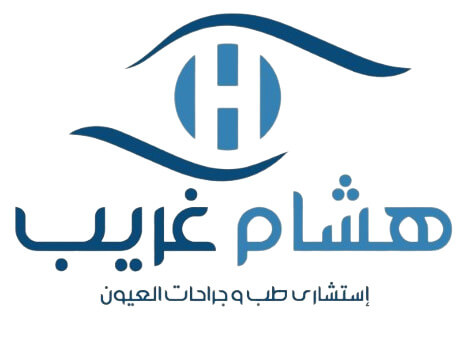Have you ever wondered how diabetes can affect your eyesight? If you’re living with diabetes—whether type 1 or type 2—you may be at risk of developing a serious eye condition known as diabetic retinopathy. This diabetic retina disease is one of the leading causes of vision loss worldwide, including in Egypt. But the good news is: early detection and proper treatment can help protect your vision.
In this article, Dr. Hesham Gharib, a leading ophthalmologist in Cairo and Giza, explains everything you need to know about diabetes eye complications, including symptoms, retinal damage stages, treatment options, and how to stay ahead of this condition with regular eye care.

What Is Diabetic Retinopathy?
Diabetic retinopathy is a complication of diabetes that affects the blood vessels in the retina—the light-sensitive tissue at the back of the eye. High blood sugar levels over time can damage these tiny vessels, leading to fluid leakage, retinal swelling, or even abnormal blood vessel growth, which can cause retina bleeding or scarring.
The condition typically develops silently, with no obvious symptoms in the early stages. That’s why it’s often called a “silent threat” to vision.
Related terms:
- Blurry vision from diabetes
- Macular edema diabetes
- Diabetes and blindness
How Does It Progress Over Time? (Retinopathy Stages Explained)
Diabetic retinopathy usually progresses through four main stages:
- Mild Non-Proliferative Retinopathy
Small balloon-like swelling (microaneurysms) form in the blood vessels of the retina. Often there are no symptoms. - Moderate Non-Proliferative Retinopathy
Blood vessels may swell and distort, affecting blood flow and leading to early signs of retinal swelling from diabetes. - Severe Non-Proliferative Retinopathy
More blood vessels become blocked, depriving areas of the retina of oxygen. This triggers signals for new abnormal vessel growth. - Proliferative Diabetic Retinopathy (PDR)
The most advanced stage. New fragile blood vessels grow and may bleed into the eye (vitreous hemorrhage). This stage can lead to retinal detachment and permanent vision loss if not treated.
Understanding these retinal damage stages helps doctors choose the best treatment method at the right time.
Key Warning Signs to Watch
Although early diabetic retinopathy may not cause noticeable symptoms, as the disease progresses, you may begin to experience:
- Blurry or distorted vision
- Dark spots or floaters
- Poor night vision
- Sudden loss of vision in one or both eyes
- Fluctuating vision
If you notice any of these changes, especially if you’re diabetic, seek immediate attention at a Cairo diabetic eye clinic.
Diagnostic Tools and Early Detection
Early detection is crucial in managing diabetic retinopathy. At Dr. Hesham Gharib’s clinic in Cairo, we use the latest diagnostic tools to catch signs of diabetic retina disease before they cause irreversible damage.
Key tests include:
OCT for diabetic retina
Optical Coherence Tomography (OCT) creates detailed cross-sectional images of the retina to detect retinal swelling, macular edema, and other structural changes.
Dilated Fundus Examination
Allows the ophthalmologist to see the back of the eye clearly and assess blood vessels, bleeding, or new abnormal growths.
Fluorescein Angiography
Used to examine blood flow in the retina and identify leaking vessels.
Regular screenings are a key part of diabetic eye monitoring, especially if you’ve had diabetes for several years or have uncontrolled blood sugar.
Main Treatment Options: Injections, Laser, Surgery
The goal of treatment is to slow the progression of the disease and prevent further vision loss.
Injection for Diabetic Retinopathy
Anti-VEGF injections (such as Avastin, Eylea, or Lucentis) reduce abnormal blood vessel growth and leakage. These are often used in cases of macular edema diabetes or proliferative retinopathy.
- Usually done monthly in the beginning
- Quick and painless procedure
- Helps restore or stabilize vision
Laser for Diabetic Eyes
Laser photocoagulation is used to seal leaking blood vessels or shrink abnormal ones. It can be performed in the clinic and helps reduce the risk of serious complications like retinal detachment.
- Useful for both macular edema and advanced stages
- Safe and effective for many patients
Surgery (Vitrectomy)
In severe cases with retina bleeding or retinal detachment, vitrectomy surgery may be necessary. This procedure removes the vitreous gel and replaces it with a clear solution.
- Done in an operating room
- Recommended for late-stage disease or non-responsive cases
Importance of Regular Checkups for Diabetics
Many patients ask, “How can I prevent diabetic retinopathy?”
The answer lies in regular eye care for diabetics in Egypt, proper diabetes management, and early diagnosis. At Dr. Hesham Gharib’s Cairo clinic, we recommend:
- Annual eye exams for all diabetic patients
- More frequent visits if you already have signs of retinopathy
- Immediate checkup if you notice any vision changes
By staying proactive, you can avoid serious complications and maintain healthy vision.
FAQs About Treatment Outcomes
Can diabetic retinopathy be reversed?
Not entirely. However, early treatment can halt progression and even improve vision in some cases.
Is the injection for diabetic retinopathy painful?
Most patients experience only mild discomfort. Numbing drops are used before the injection.
How many injections will I need?
This depends on your condition. Many patients start with monthly injections, then taper down based on response.
Does laser treatment cure the condition?
Laser helps prevent further damage, but it does not cure the disease. It’s part of long-term management.
Can I go blind from diabetic retinopathy?
If left untreated, yes. But with proper care, vision loss can often be prevented.
Diabetic retinopathy is a serious yet manageable condition. With proper diabetic eye monitoring, modern treatments like injections, laser for diabetic eyes, and expert guidance from a trusted ophthalmologist like Dr. Hesham Gharib, you can protect your sight and quality of life.

